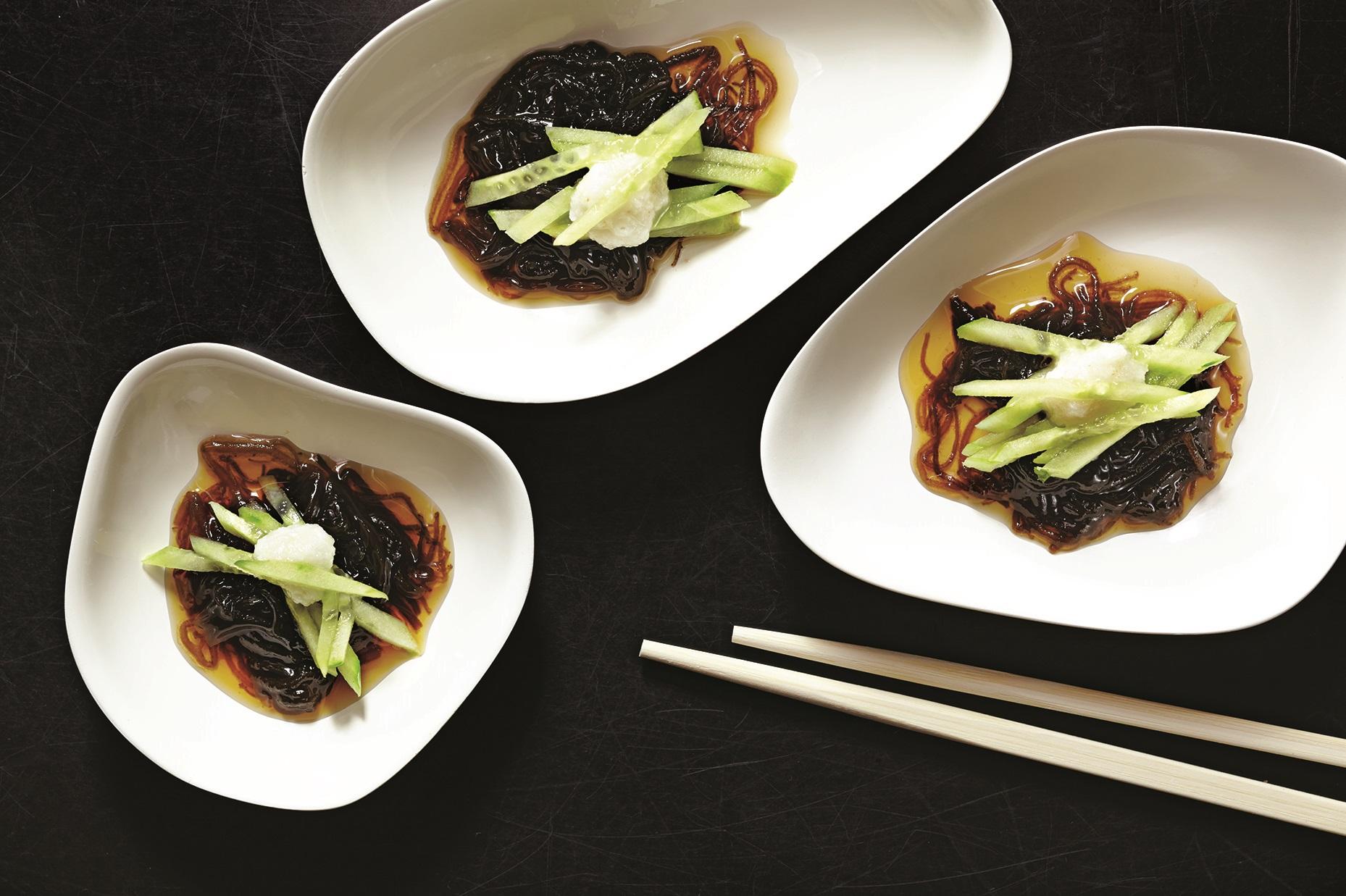Marinated mozuku seaweed with cucumber
I love Japanese cuisine. Before I die, I want to make my way to a sushi bar in Tokyo and taste a ramen noodle dish in Kyoto.
But after reading the latest issue of Saveur, I will have to add a visit to Okinawa. Okinawa is in the southernmost region of Japan, an island about a three-hour flight from Tokyo.
Apparently I'm not alone in my ignorance of the food in Okinawa. One chef in the Saveur article describes the city as the "lost child of Japan."
Laurie Woolever wrote the article. She says the food in Okinawa is different from the rest of Japan, in part because the island has been greatly influenced by other parts of the world. This includes China, Portugal and the United States, which governed the island for decades after World War II and still maintains a large military base there.
There's also a slower pace on the island. Woolever says Okinawa is a lot like "southern California or Hawaii … people still take pride in the way their food looks and tastes, but it's dialed down several notches."
The preparation is also slightly different. It's "looser" in Okinawa, while in the rest of Japan the preparation is "very precise, very accurate."
That's not to say you can't find your standard fish, rice and noodle dishes in Okinawa, but it's worth noting the soba on Okinawa is made with wheat flour and eggs as opposed to buckwheat that's more commonly used on Japan's mainland. Woolever says this change in ingredients adds its own distinct flavor.
Laurie Woolever travelled to Okinawa as part of the TV crew for Anthony Bourdain: Parts Unknown. The one dish she had a lot was the Goya Champuru. It's a stir-fry and "is quite hearty, a real comfort food."
.jpg&w=1920&q=75)
And do you want one more reason why a trip to Okinawa is mandatory? You can live forever. Not really, of course, but there is something about the Okinawa diet that has people living a long time. Woolever says there's "a lot of root vegetables, a lot leafy greens, certain types of fish … and just a small piece of pork that might flavor a broth."
However, because of the international influences, the diet in Okinawa is changing. And not for the better. There's "more meat, more fast food, more processed foods," says Woolever.
Perhaps I should plan my trip a lot sooner — and not wait until retirement.
GOYA CHAMPURU – Bitter melon and tofu stir-fry with pork belly and eggs
Soft tofu, scrambled eggs, and rich pork belly stand up to the astringent bitter melon flesh in this flavorful stir-fry. Salting the melon leaches out much of its harsh tannins, so don't skip this step or the dish will be unpalatably bitter.
SERVES 4
1 HOUR, 15 MINUTES
Ingredients:
3 small bitter melons (about 12 oz.)
2 tbsp. kosher salt
7 oz. extra-firm tofu
1 tbsp. vegetable oil
4 oz. pork belly, skin removed, thinly sliced crosswise
1⁄3 cup dashi (see Noodles in Dashi for recipe)
1 tbsp. soy sauce
2 large eggs, lightly beaten
1⁄4 cup bonito flakes
Koregusu (Okinawan chile sauce), optional
Instructions:
Cut each bitter melon in half lengthwise and, using a spoon, remove and discard the seeds. Slice the bitter melons crosswise into 1⁄4-inch-thick half-moons and transfer to a medium bowl. Add the salt, toss until evenly combined, and let stand for 20 minutes. Using your hands, squeeze the bitter melon to release as much liquid as possible, then transfer to a colander and rinse under cold running water. Squeeze again to drain any liquid, transfer to paper towels, and pat dry.
Place the tofu on a flat plate lined with a kitchen towel. Cover the tofu with another towel and plate and then weight the plate with two 32-oz. cans to press the tofu and release excess water. Let the tofu stand for at least 20 minutes. Remove the weights and uncover the tofu. Using your hands, crumble the tofu into 1-inch pieces into a large bowl.
In a 12-inch skillet, heat the oil over high. Add the bitter melon and pork and cook, undisturbed, for 5 minutes. Stir and cook 2 minutes more. Add the tofu along with the dashi and soy sauce and cook until the liquid has almost completely evaporated, about 1 minute. Pour in the eggs and cook, stirring to break up the curds, until the eggs are just cooked, 1 to 2 minutes more. Remove the skillet from the heat and scrape the stir-fry onto a serving platter. Sprinkle with bonito flakes and serve immediately with the koregusu, if using.
You can find more receipes for Okinawa dishes at Saveur.
The World is an independent newsroom. We’re not funded by billionaires; instead, we rely on readers and listeners like you. As a listener, you’re a crucial part of our team and our global community. Your support is vital to running our nonprofit newsroom, and we can’t do this work without you. Will you support The World with a gift today? Donations made between now and Dec. 31 will be matched 1:1. Thanks for investing in our work!
